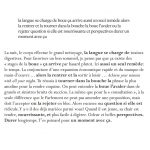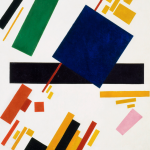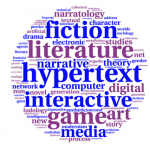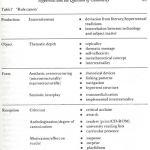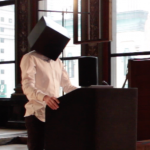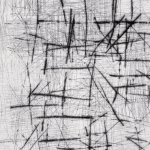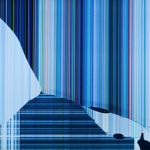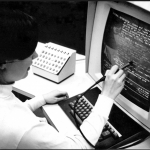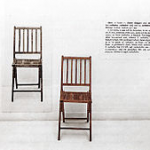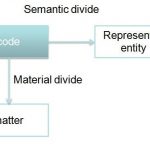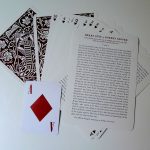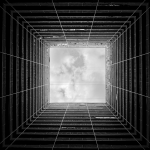2015
In this essay, John Cayley builds upon a critical legacy that reflects intensively on the process of literature in an age of machine language. Building on a legacy that includes ebr classics like “The Code is not the Text” and many points in between, “Beginning with ‘The Image’” points to the difficulties of translating a procedural code-based text that “finds” its substance in the repository of text known as the World Wide Web.
Salter's "Convergent Devices, Dissonant Genres" assesses the implications of the iPad for the state of literature. Looking at "traditional" approaches that re-mediate print for digital devices, "enhanced" approaches which add "special features" to extant texts and forms, pre-tablet eliterature re-experienced in the new environment, and finally the creation of original apps with literary qualities, Salter's work is a critical document of the impact a single interface can have on the development of literary culture in the 21st Century.
2014
E-lit authors Stephanie Strickland and Marjorie Luesebrink organized a panel on the "Future of E--Lit" at the ELO 2012 conference, allowing emerging and early career authors to articulate institutional and economic, as well more familiar technological, developments that constrain and facilitate current practice. The panel papers were released in ebr in March 2014. Luesebrink and Strickland followed up with comments on the papers, offering a "progress report" on the future of the field. The individual responses are available as glosses on the essays and in full here.
Jill Walker Rettberg’s Visualizing Networks of Electronic Literature maps the fragmentary and dynamic field of electronic literature by analyzing citations in 44 doctoral dissertations published between 2002 and 2013. Applying “distant reading” strategies to the ELMCIP Knowledge Base, Rettberg identifies key works in the field, shifting genres, and changing approaches to scholarship.
Scott Rettberg's essay, "An Emerging Canon?", highlights the potential for macroanalytic approaches to literary study, specifically in the field of electronic literature. Through his study of the richly populated ELMCIP Knowledge Base, Rettberg analyzes the impact that specific works have had within scholarly and creative communities, and enumerates the potential benefits that this work might have for the preservation, study, and understanding of the field.
In "Nature's Agents," Lisa Swanstrom discusses the agency of objects operating within networks. Specifcally, Swanstrom addresses works which allow nature to correspond with humans in a shared environment, posing provocative questions about the idea of agency itself as expressed in an ecology of action.
This essay is excerpted from Swanstrom's monograph, Animal, Vegetable, Digital: Experiments in New Media Aesthetics and Environmental Poetics (under contract to be published by the University of Alabama Press).
In the following essay, Luciana Gattass discusses the formation of a Brazilian Electronic Literature Collection via analysis of works identified in the ELMCIP Knowledge Base. Positioned between the existence of geographical data and the question of a national literature, Gattass considers the role of the human critic in the age of big data.
The "electronicness" in literary writing, Ian Hatcher suggests, is more of a cognitive disposition, an atmosphere or condition that is present regardless of the print/screen/pen(cil)/paper medium one inhabits.
Natalia Fedorova claims sees the future of electronic literature in translation: just as translation from her native Russian to English can teach us about both of those languages, translations between "natural languages" and "languages of code" can clarify what makes electronic language literary.
Recalling ebr's early exploration into "green" and "grey" ecologies, invisible etchings on silicon and massive environmental consequences, Ben Bishop calls our attention to questions of "power" at the heart of our newly digitized critical and creative practices: "Not clout or capability, but electrical power generated by spinning turbines."
Brian Kim Stefans proposes the need for a resistance to the "free play" associated with electronic writing, and discusses how this resistance will elevate electronic literature for both the author and the reader. He argues that poetic discharge is comparable with excess and bodily disgust, citing Sianne Ngai, and Steve McCaffery's "North of Intention." Stefans argues that avant-garde excess must be based on a balanced reflection on authorial presences. He draws his argument from his work on The Scriptor Project, which was inspired by his desire to bring "digital textuality back to the drama of the hand making marks on the page - literally dramatizing the act of writing by hand, the plays of body and mind that are erased in standard typography."
2013
In this essay, Davin Heckman argues that works of electronic literature often provide occasions for cultivating attention in a mutable cultural landscape. Through readings of John Cayley, YHCHI, Rob Wittig, and Richard Holeton, Heckman points to a poetics of technical estrangement by which new media is opened up to deliberative reading, and thus presents contemporary readers with the opportunity to develop critical practices appropriate for the conditions of neoliberalism.
2012
Florian Cramer's essay reframes debates on electronic literature within larger cultural developments in writing and publishing. On the one hand, he shows the commitment of the field of electronic literature - as found in universities or in organizations such as the ELO - to a "literary" intermedia writing for electronic (display) media. On the other hand, he emphasizes a wide-ranging post-digital poetics defined by a DIY media practice rather than the choice of a particular medium, a poetics which is broadly orientated towards writing rather than literature. At stake in this opposition is the larger question of literary studies in a world of creative digital industries.
Jhave's wide-ranging history and prospectus alerts us to cognitive, material, and mythic dimensions of the nexus of image and text. By showing how text evolved into image, the essay traces a new malleability, dimensionality, and embodiment of writing. The contemporary image-text is a quasi-object with experimental literary qualities as well as an almost organic media dynamism.
Serge Bouchardon and Davin Heckman put the digit back into the digital by emphasizing touch and manipulation as basic to in digital literature. The digital literary work unites figure, grasp, and memory. Bouchardon and Heckman show that digital literature employs a rhetoric of grasping. It figures interaction and cognition through touch and manipulation. For Bouchardon and Heckman, figure and grasp lead to problems of memory - how do we archive touch and manipulation? - requiring renewed efforts on the part of digital literary writers and scholars.
Zuzana Husárová and Nick Montfort up the ante for experimental writing by examining the category of "shuffle literature." What is shuffle literature? Simply put: books that are meant to be shuffled. Using formal reading of narrative and themes, but also a material reading of construction and production, Husárová and Montfort show that there are many writing practices and readerly strategies associated with this diverse category of literature.
Can a corporate-dominated Web become an environment conducive to literary activity? The novelist, essayist, and cultural critic Curtis White is skeptical. Responding to criticisms of his account of the devolution of literary publishing and reflecting on the prevalence of market-driven values in online exchanges, White doubts whether literature can distinguish itself in the noisy new media ecology, which he likens to a high-tech prison house.
2011
Two innovative contemporary writers discuss the relationship between encyclopedic narrative and notions of gender and writing, the body as the physical embodiment of memory, and the unique syntax of Tillman's American Genius, A Comedy. The novel's prose depicts the way "thought, when you're not thinking, happens."
In his introduction to the Cognitive Fictions cluster, Joseph Tabbi suggests that reflexive, non-narrative literature plays a critical role in the new media ecology. Postmodernist writing by Joseph McElroy and Italo Calvino, the posthumanist thought of Cary Wolfe, and the emerging forms of electronic literature each occupy a position between narrative modes of consciousness and "object-oriented" computer and cognitive science.
2010
In his new book, Michael Wutz examines how the work of four canonical novelists - Norris, Lowry, Doctorow, and Powers - register the revolutions in 20th century media technology. Such an analysis, reviewer Joseph Conte suggests, is an important extension of Kittlerian media theory to the field of American literature.
